2021届高考二轮英语复习课件:主谓一致课件(共41张ppt)
文档属性
| 名称 | 2021届高考二轮英语复习课件:主谓一致课件(共41张ppt) |
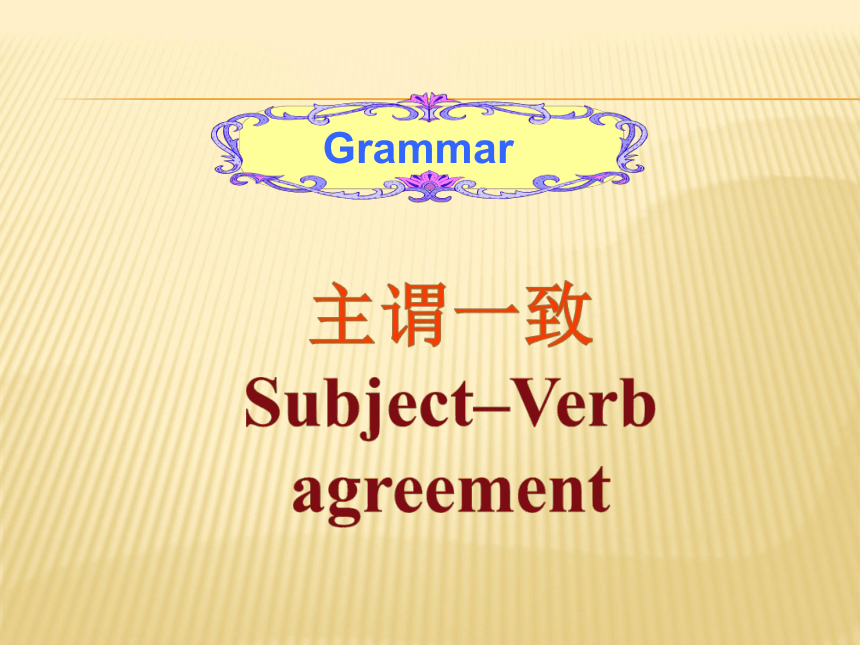
|
|
| 格式 | pptx | ||
| 文件大小 | 2.0MB | ||
| 资源类型 | 教案 | ||
| 版本资源 | 通用版 | ||
| 科目 | 英语 | ||
| 更新时间 | 2021-05-20 07:43:20 | ||
图片预览

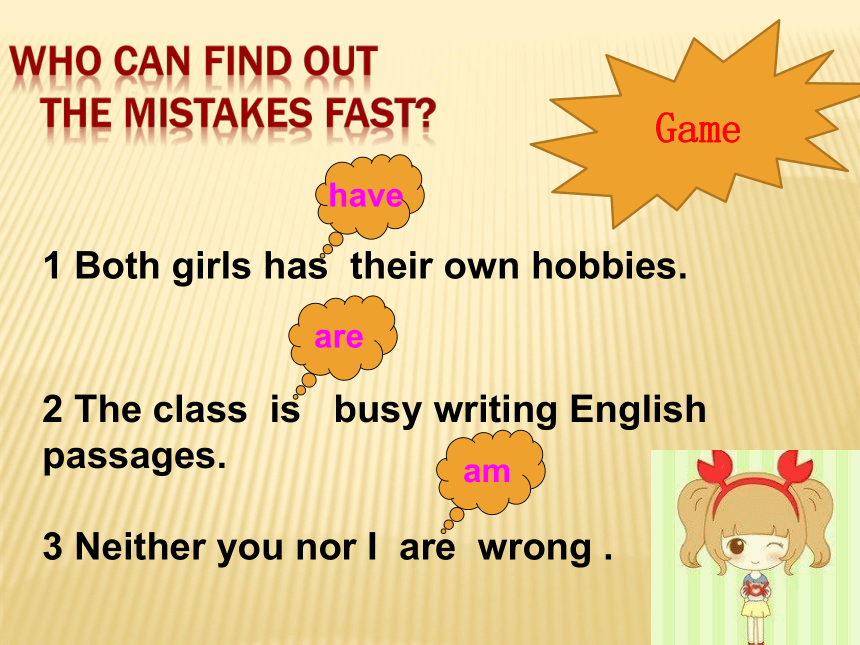
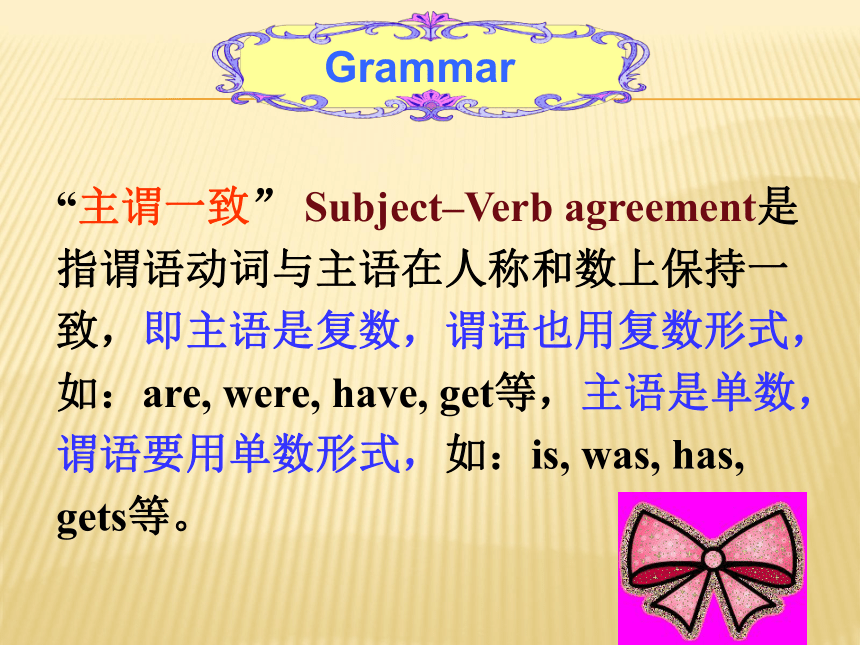

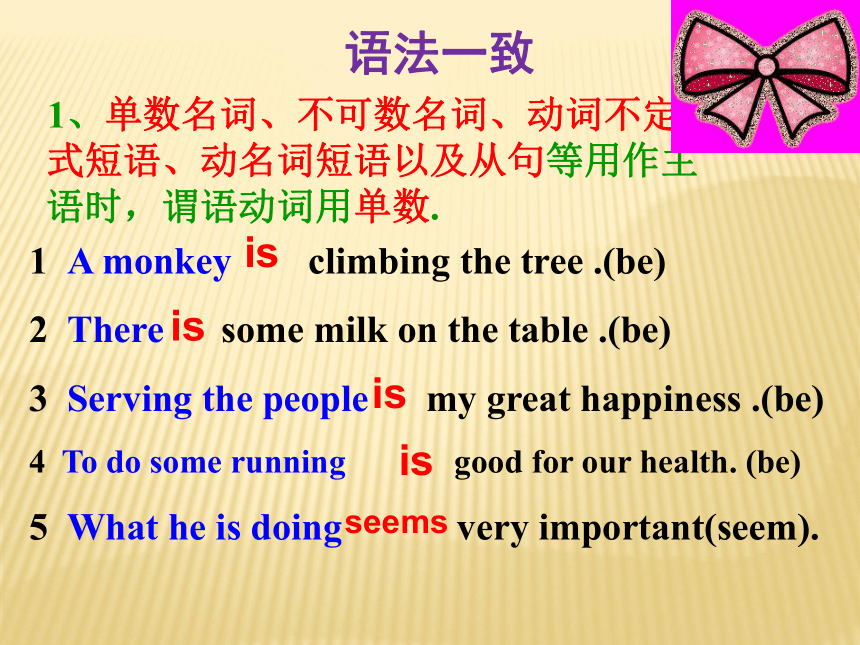
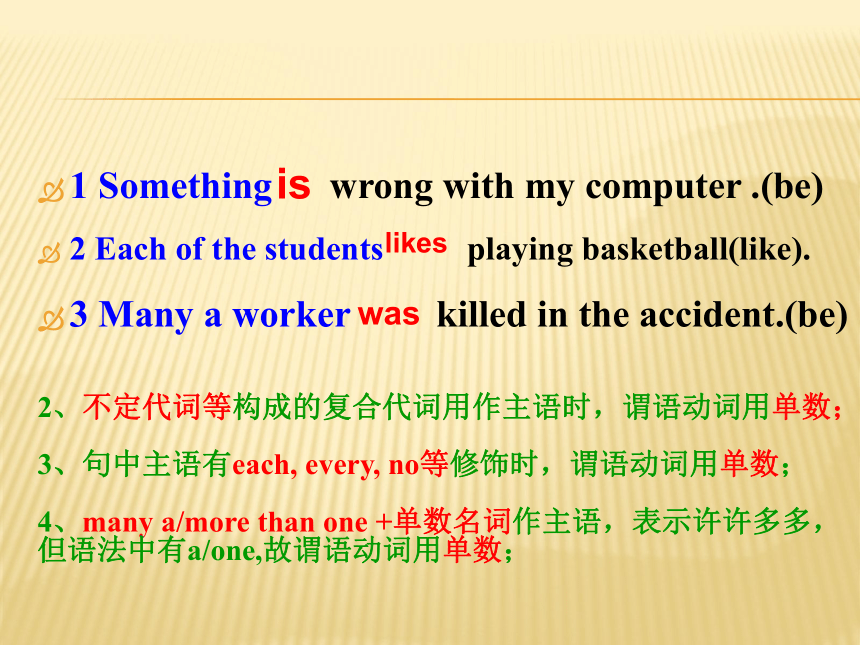

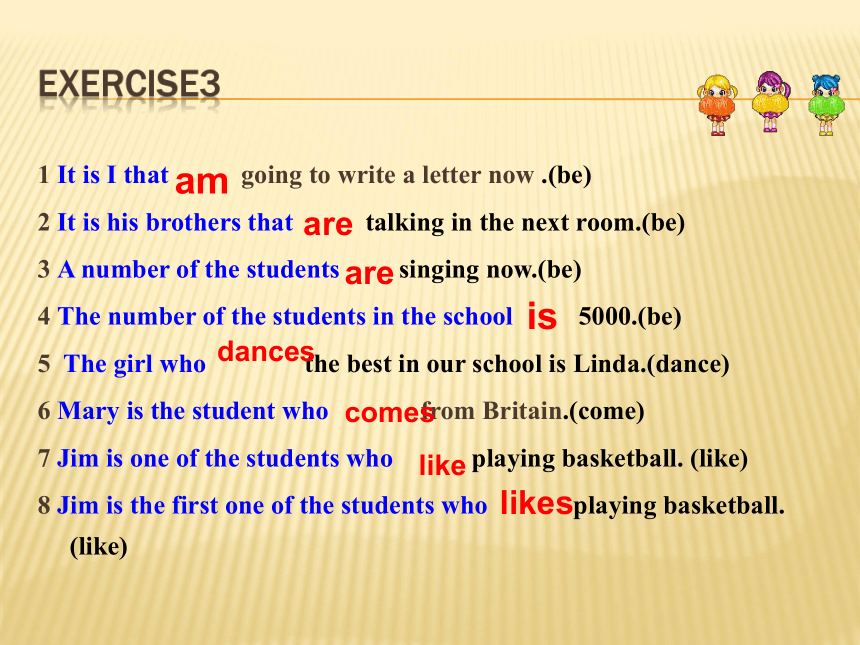


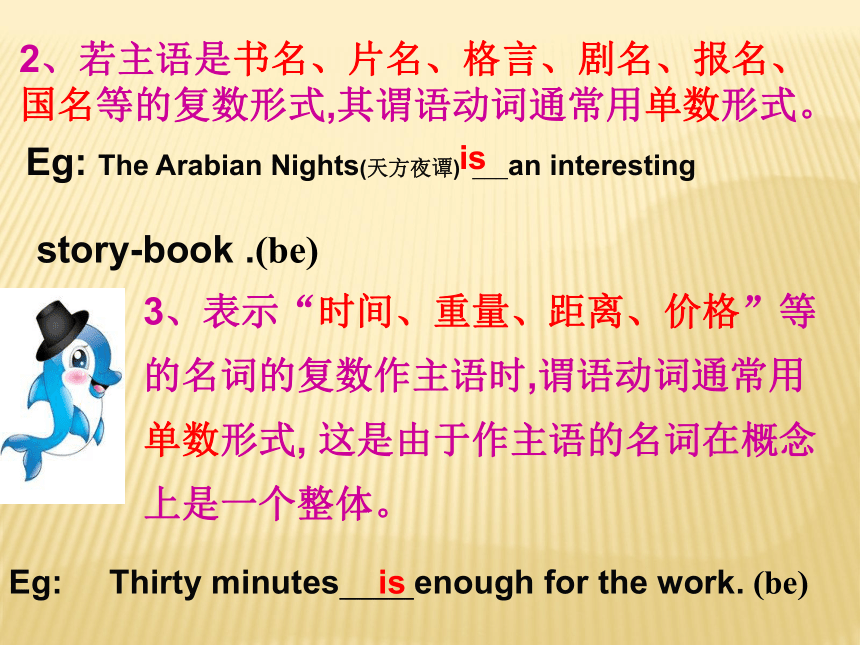
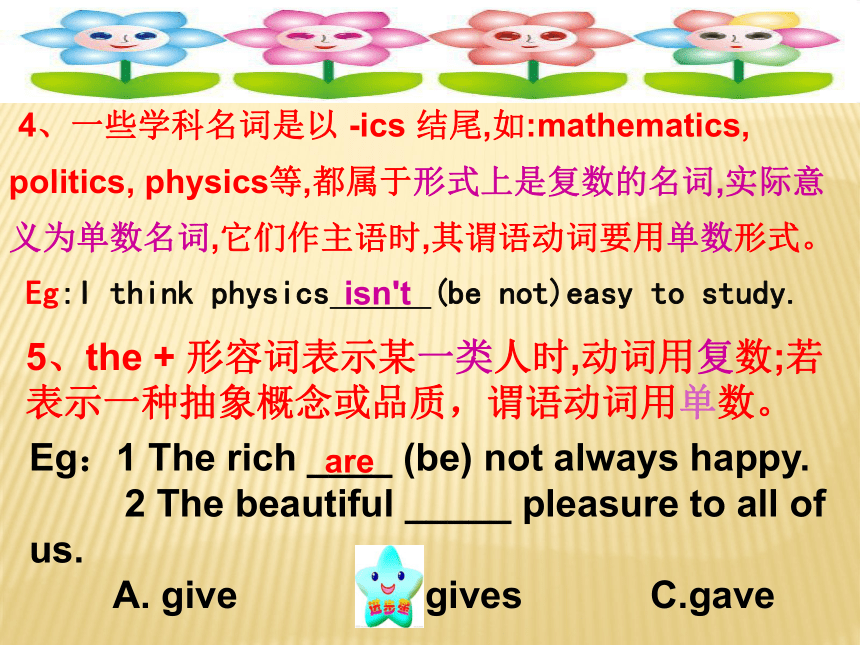
文档简介
主谓一致Subject–Verb agreement
Grammar
1 Both girls has their own hobbies.
2 The class is busy writing English passages.
3 Neither you nor I are wrong .
Who Can find out
the mistakes fast?
have
are
am
Game
Grammar
“主谓一致” Subject–Verb agreement是指谓语动词与主语在人称和数上保持一致,即主语是复数,谓语也用复数形式,如:are, were, have, get等,主语是单数,谓语要用单数形式,如:is, was, has, gets等。
主谓一致主要四大原则:
主谓一致
一、语法一致
二、意义一致
三、就近原则
四、就远原则
1、单数名词、不可数名词、动词不定式短语、动名词短语以及从句等用作主语时,谓语动词用单数.
1 A monkey climbing the tree .(be)
2 There some milk on the table .(be)
3 Serving the people my great happiness .(be)
4 To do some running good for our health. (be)
5 What he is doing very important(seem).
is
is
is
is
seems
语法一致
1 Something wrong with my computer .(be)
2 Each of the students playing basketball(like).
3 Many a worker killed in the accident.(be)
is
likes
was
2、不定代词等构成的复合代词用作主语时,谓语动词用单数;
3、句中主语有each, every, no等修饰时,谓语动词用单数;
4、many a/more than one +单数名词作主语,表示许许多多,但语法中有a/one,故谓语动词用单数;
5、 复数名词或集体名词作主语时,谓语动词用复数形式。
6、当and 或both…and 连接两个名词作并列主语时,谓语动词用复数。
1 Books our good friends .(be)
2 Chinese hardworking and brave .(be)
3 Jack and Peter my classmates.(be)
4 Both Rose and Lucy interested in dancing. (be)
are
are
are
are
Exercise3
1 It is I that going to write a letter now .(be)
2 It is his brothers that talking in the next room.(be)
3 A number of the students singing now.(be)
4 The number of the students in the school 5000.(be)
5 The girl who the best in our school is Linda.(dance)
6 Mary is the student who from Britain.(come)
7 Jim is one of the students who playing basketball. (like)
8 Jim is the first one of the students who playing basketball. (like)
am
are
are
is
dances
comes
like
likes
三、下列情况谓语动词单数或复数要根据具体句子确定
1、在It is/was...that/who...这个强调句型中,如果被强调的部分是主语,其从句中的谓语动词应该与被强调的词保持一致。
2、当a number of和the number of加名词复数作主语时,其谓语动词用法不同。a number of后接可数名词复数,表示“许多”,相当于many,修饰其后面的名词,谓语动词要用复数;而the number of 则表示“...的数目”,后面所接的可数名词复数用作后置定语,主语是the number,所以谓语动词只能用单数.
3、在定语从句中,关系代词who,that,which等用作主语时,其谓语动词的单复数应与先行词的单、复数保持一致。
注意:one of +复数名词+定语从句,从句的谓语用复数,但如果one的前面有the only,the very,the first修饰时,定语从句的谓语就用单数。
语法一致
1、如果集体名词指的是整个集体,它的谓语动词用单数;如果它指集体的成员,其谓语动词就用复数形式。这些词有family, class, crowd, team,group等。
如:Class Four on the third floor. (be)
Class Four studying in the classroom.
is
are
are
意义一致原则
注意:people, police等名词一般都用作复数。
如:The police looking for the lost child.(be)
is
is
3、表示“时间、重量、距离、价格”等的名词的复数作主语时,谓语动词通常用单数形式, 这是由于作主语的名词在概念上是一个整体。
2、若主语是书名、片名、格言、剧名、报名、
国名等的复数形式,其谓语动词通常用单数形式。
Eg: The Arabian Nights(天方夜谭) an interesting
story-book .(be)
Eg: Thirty minutes enough for the work. (be)
Eg:I think physics (be not)easy to study.
isn't
4、一些学科名词是以 -ics 结尾,如:mathematics, politics, physics等,都属于形式上是复数的名词,实际意义为单数名词,它们作主语时,其谓语动词要用单数形式。
5、the + 形容词表示某一类人时,动词用复数;若表示一种抽象概念或品质,谓语动词用单数。
Eg:1 The rich ____ (be) not always happy.
2 The beautiful _____ pleasure to all of us.
A. give B. gives C.gave
are
6.若and所连接的两个名词作主语,如果是指同一概念(即and后面无冠词)时,谓语动词用单数形式。
has
have
1 The writer and artist come. (have)
2 The writer and the artist come. (have)
Every student and every teacher___ in
the room.
A. was B. were C. are
7. 不定代词each/every/no+名词+and +each/ every/no+名词作主语时,谓语动词仍用单数
形式。
8. 由分数或百分数或a lot of, lots of, half of, the rest of, some of, most of, all of , (a) part of ,half of+名词作主语时,谓语动词的形式与of 后面的名词的数一致.
are
is
1 Some students are planting trees.
The rest of them ______(be) watering them.
2 On the earth about 75% of the surface____ (be) covered with water
9、表示成双成套的名词,如:trousers, glasses, clothes, shoes 等词作主语时,谓语用复数,但如果这些名词前有a (the) pair/two pairs of等量词修饰时,谓语动词要和pair的形式保持一致。
are
is
1 My glasses broken .(be)
2 The pair of shoes under the bed his. (be)
11、what, who, which, any, more, all等代词作主语时,谓语可以是单数,也可是复数,主要靠意思来决定。
is
are
is
1 Which your bag?(be)
2 Which your bags?(be)
3 All going well.(be)
(三)就近一致原则。
are
is
1、当两个主语由either … or, neither … nor, not only … but (also),not…but…或or连接时,谓语动词和邻近的主语一致。
如:1 Either the teacher or the students our friends. (be)
2 Neither they nor he right. (be)
2、there be句型be动词单复数取决于其后的主语。如果其后是由and连接的两个主语,则应与靠近的那个主语保持一致。
???
are
is
1 There two chairs and a desk in the room. (be)
2 There a desk and two chairs in the room.(be)
Eg:1 There the bus.(come)
2 On the wall many pictures.(be)
3 Such the result.(be)
comes
are
is
3、在倒装句中,谓语动词的数应与其后的主语一致。
就近原则是指当句中出现并列主语时,谓语动词的单复数形式取决于最靠近它的主语。
1.由or, either...or, neither...nor, not only...but also, not...but等连接的并列主语,谓语动词与靠近谓语动词的主语一致。
2. 在there be或here句型中,主语是两个或多个并列名词(短语),谓语动词与最近的一个名词(短语)保持一致
3. 在倒装句中,谓语动词和后面的第一个主语保持一致。
三、就近原则
1. The teacher with two students ____ at the meeting . (was / were)
2.E-mail, as well as the telephones, ________ an
important part in daily communication.
A. is playing B. have played C. are playing
was
A
主语为单数名词或代词,尽管后面跟有with, together with,along with, except, but, like, as well as, rather than, more than, no less than, besides, including等引起的短语,谓语动词仍用单数形式;若主语为复数,谓语用复数形式。(也就是A with B ,A为主语,谓语动词和A保持一致)
四、就远原则
Practice
Exercises:
1.One or two days ____ enough
to see the city.
A.is B.are
C.am D.be
2.Neither my wife nor I myself ____ able to persuade my daughter to change her mind.
A.is B.are
C.am D.be
one or two+c.n.pl.(a/an+单数名词+or two)作主语谓语动词用单数
3.Not only I but also Jane and Mary ____ tired of having one examination after another.
A.is B.are
C.am D.be
4.Not the teacher,but the students ____ looking forward to seeing the film.
A.is B.are
C.am D.be
5.Nobody but Betty and Mary ____ late for class yesterday.
A.was B.were
C.has been D.have been
6.A woman with some children ____ soon.
A.is coming B.are coming
C.has come D.have come
7.What you said ___ true.
A. are B. is C. were
8.The Greens _____ watching TV when I arrived.
A. is B. are C. were
9 The singer and dancer ___ on the stage. (be)
is
10 A knife and fork ___ used to have meals. (be)
is
12 The team ____ some good players. (have)
13 The team ____ handsome. (be)
has
are
14 The group ___ made up of nine students. (be)
15 The group ____ dancing happily. (be)
is
are
Summary
主谓一致
二、意义一致
三、就近原则
一、语法一致
主谓一致主要四大原则:
四、就远原则
一、下列情况谓语动词常用单数
1、单数名词、不可数名词、动词不定式短语、动名词短语以及从句等用作主语时,谓语动词用单数;
2、不定代词等构成的复合代词用作主语时,谓语动词用单数;
3、句中主语有each,every,no等修饰时,谓语动词用单数;
4、many a/more than one +单数名词作主语,表示许许多多,语法中有a/one,故谓语动词用单数;
语法一致:用作主语的名词或名词词组和谓语在单、复数形式上的一致。
二、下列情况谓语动词常用复数
1、 复数名词或集体名词作主语时,谓语动词用复数形式。
2、当and 或both…and 连接两个名词作并列主语时,谓语动词用复数。
语法一致
三、下列情况谓语动词单数或复数要根据具体句子确定
1、在It is/was...that/who...这个强调句型中,如果被强调的部分是主语,其从句中的谓语动词应该与被强调的词保持一致。
2、当a number of和the number of加名词复数作主语时,其谓语动词用法不同。a number of后接可数名词复数,表示“许多”,相当于many,修饰其后面的名词,谓语动词要用复数;而the number of 则表示“...的数目”,后面所接的可数名词复数用作后置定语,主语是the number,所以谓语动词只能用单数.
3、在定语从句中,关系代词who,that,which等用作主语时,其谓语动词的单复数应与先行词的单、复数保持一致。
注意:one of +复数名词+定语从句,从句的谓语用复数,但如果one的前面有the only,the very,the first修饰时,定语从句的谓语就用单数。
语法一致
1、某些学科名词如economics,physics,mathematics,politics等形式上的复数,而实际上是表示单数概念,这些名词作主语时,谓语动词要用单数形式。
2、某些以-s结尾表示国名和机构名称的专有名词、书报名称及某些形式是复数而意义是单数的名词,如news,means等用作主语时,谓语动词用单数形式。
3、当the+国籍名族的形容词,或the+形容词表示一类人作主语,或the+姓氏的复数形式表示一家人作主语时,谓语动词用复数形式。
4、表示时间、距离、金额、度量、重量等词用作主语时,形式上是复数,但意义上是一个整体,谓语动词要用单数形式。
5、当 and连接两个或两个以上单数名词或代词作主语时,谓语动词有以下两种情况:(1)如果and连接两个或两个以上不同的人或物作主语时,谓语动词用复数。
(2)如果and连接两个或两个以上的并列结构是指同一个人或物,或指同一概念时,谓语动词用单数,这时and后面的名词前不加冠词。
(3)如果只有and后面的名词用了所有格,则谓语动词用单数形式,如果前后两个名词都用了所有格,则谓语动词用复数形式。
6、英语中有些成对的名词,如glasses,trousers,shoes,gloves,stockings,clothes等用作主语时,谓语动词要用复数形式。但如果这类词前面用pair等量词修饰,其谓语动词的单复数要由等词来决定。
7、在英语中,一些集体名词如family,class, team等作主语,如果强调“整体”时,谓语动词用单数形式,如果强调“其中的成员”,则谓语动词用复数形式。
意义一致:主语意义上的单复数要与谓语动词的单复数形式一致。
8、如果名词词组中心词是“分数或百分数+of+名词或代词”,谓语动词的单、复数形式要根据of后的名词或代词的单、复数形式而定。
9、表示不定数量的词,如all,none,any,some,most,half等作主语,谓语动词的单复数根据名词及其含义来确定。
10、Chinese,Japanese,fish,sheep,deer,means等词单复数同行,谓语根据含义来决定单复数。
Eg,
Every means been tried.
All means been tried
意义一致
has
have
就近原则是指当句中出现并列主语时,谓语动词的单复数形式取决于最靠近它的主语。
1.由or, either...or, neither...nor, not only...but also, not...but等连接的并列主语,谓语动词与靠近谓语动词的主语一致。
2. 在there be或here句型中,主语是两个或多个并列名词(短语),谓语动词与最近的一个名词(短语)保持一致
3. 在倒装句中,谓语动词和后面的第一个主语保持一致。
三、就近原则
主语为单数名词或代词,尽管后面跟有with, together with,along with, except, but, like, as well as, rather than, more than, no less than, besides, including等引起的短语,谓语动词仍用单数形式;若主语为复数,谓语用复数形式。
(也就是A with B ,A为主语,谓语动词和A保持一致)
四、就远原则
Review what we have learnt today.
Homework
Grammar
1 Both girls has their own hobbies.
2 The class is busy writing English passages.
3 Neither you nor I are wrong .
Who Can find out
the mistakes fast?
have
are
am
Game
Grammar
“主谓一致” Subject–Verb agreement是指谓语动词与主语在人称和数上保持一致,即主语是复数,谓语也用复数形式,如:are, were, have, get等,主语是单数,谓语要用单数形式,如:is, was, has, gets等。
主谓一致主要四大原则:
主谓一致
一、语法一致
二、意义一致
三、就近原则
四、就远原则
1、单数名词、不可数名词、动词不定式短语、动名词短语以及从句等用作主语时,谓语动词用单数.
1 A monkey climbing the tree .(be)
2 There some milk on the table .(be)
3 Serving the people my great happiness .(be)
4 To do some running good for our health. (be)
5 What he is doing very important(seem).
is
is
is
is
seems
语法一致
1 Something wrong with my computer .(be)
2 Each of the students playing basketball(like).
3 Many a worker killed in the accident.(be)
is
likes
was
2、不定代词等构成的复合代词用作主语时,谓语动词用单数;
3、句中主语有each, every, no等修饰时,谓语动词用单数;
4、many a/more than one +单数名词作主语,表示许许多多,但语法中有a/one,故谓语动词用单数;
5、 复数名词或集体名词作主语时,谓语动词用复数形式。
6、当and 或both…and 连接两个名词作并列主语时,谓语动词用复数。
1 Books our good friends .(be)
2 Chinese hardworking and brave .(be)
3 Jack and Peter my classmates.(be)
4 Both Rose and Lucy interested in dancing. (be)
are
are
are
are
Exercise3
1 It is I that going to write a letter now .(be)
2 It is his brothers that talking in the next room.(be)
3 A number of the students singing now.(be)
4 The number of the students in the school 5000.(be)
5 The girl who the best in our school is Linda.(dance)
6 Mary is the student who from Britain.(come)
7 Jim is one of the students who playing basketball. (like)
8 Jim is the first one of the students who playing basketball. (like)
am
are
are
is
dances
comes
like
likes
三、下列情况谓语动词单数或复数要根据具体句子确定
1、在It is/was...that/who...这个强调句型中,如果被强调的部分是主语,其从句中的谓语动词应该与被强调的词保持一致。
2、当a number of和the number of加名词复数作主语时,其谓语动词用法不同。a number of后接可数名词复数,表示“许多”,相当于many,修饰其后面的名词,谓语动词要用复数;而the number of 则表示“...的数目”,后面所接的可数名词复数用作后置定语,主语是the number,所以谓语动词只能用单数.
3、在定语从句中,关系代词who,that,which等用作主语时,其谓语动词的单复数应与先行词的单、复数保持一致。
注意:one of +复数名词+定语从句,从句的谓语用复数,但如果one的前面有the only,the very,the first修饰时,定语从句的谓语就用单数。
语法一致
1、如果集体名词指的是整个集体,它的谓语动词用单数;如果它指集体的成员,其谓语动词就用复数形式。这些词有family, class, crowd, team,group等。
如:Class Four on the third floor. (be)
Class Four studying in the classroom.
is
are
are
意义一致原则
注意:people, police等名词一般都用作复数。
如:The police looking for the lost child.(be)
is
is
3、表示“时间、重量、距离、价格”等的名词的复数作主语时,谓语动词通常用单数形式, 这是由于作主语的名词在概念上是一个整体。
2、若主语是书名、片名、格言、剧名、报名、
国名等的复数形式,其谓语动词通常用单数形式。
Eg: The Arabian Nights(天方夜谭) an interesting
story-book .(be)
Eg: Thirty minutes enough for the work. (be)
Eg:I think physics (be not)easy to study.
isn't
4、一些学科名词是以 -ics 结尾,如:mathematics, politics, physics等,都属于形式上是复数的名词,实际意义为单数名词,它们作主语时,其谓语动词要用单数形式。
5、the + 形容词表示某一类人时,动词用复数;若表示一种抽象概念或品质,谓语动词用单数。
Eg:1 The rich ____ (be) not always happy.
2 The beautiful _____ pleasure to all of us.
A. give B. gives C.gave
are
6.若and所连接的两个名词作主语,如果是指同一概念(即and后面无冠词)时,谓语动词用单数形式。
has
have
1 The writer and artist come. (have)
2 The writer and the artist come. (have)
Every student and every teacher___ in
the room.
A. was B. were C. are
7. 不定代词each/every/no+名词+and +each/ every/no+名词作主语时,谓语动词仍用单数
形式。
8. 由分数或百分数或a lot of, lots of, half of, the rest of, some of, most of, all of , (a) part of ,half of+名词作主语时,谓语动词的形式与of 后面的名词的数一致.
are
is
1 Some students are planting trees.
The rest of them ______(be) watering them.
2 On the earth about 75% of the surface____ (be) covered with water
9、表示成双成套的名词,如:trousers, glasses, clothes, shoes 等词作主语时,谓语用复数,但如果这些名词前有a (the) pair/two pairs of等量词修饰时,谓语动词要和pair的形式保持一致。
are
is
1 My glasses broken .(be)
2 The pair of shoes under the bed his. (be)
11、what, who, which, any, more, all等代词作主语时,谓语可以是单数,也可是复数,主要靠意思来决定。
is
are
is
1 Which your bag?(be)
2 Which your bags?(be)
3 All going well.(be)
(三)就近一致原则。
are
is
1、当两个主语由either … or, neither … nor, not only … but (also),not…but…或or连接时,谓语动词和邻近的主语一致。
如:1 Either the teacher or the students our friends. (be)
2 Neither they nor he right. (be)
2、there be句型be动词单复数取决于其后的主语。如果其后是由and连接的两个主语,则应与靠近的那个主语保持一致。
???
are
is
1 There two chairs and a desk in the room. (be)
2 There a desk and two chairs in the room.(be)
Eg:1 There the bus.(come)
2 On the wall many pictures.(be)
3 Such the result.(be)
comes
are
is
3、在倒装句中,谓语动词的数应与其后的主语一致。
就近原则是指当句中出现并列主语时,谓语动词的单复数形式取决于最靠近它的主语。
1.由or, either...or, neither...nor, not only...but also, not...but等连接的并列主语,谓语动词与靠近谓语动词的主语一致。
2. 在there be或here句型中,主语是两个或多个并列名词(短语),谓语动词与最近的一个名词(短语)保持一致
3. 在倒装句中,谓语动词和后面的第一个主语保持一致。
三、就近原则
1. The teacher with two students ____ at the meeting . (was / were)
2.E-mail, as well as the telephones, ________ an
important part in daily communication.
A. is playing B. have played C. are playing
was
A
主语为单数名词或代词,尽管后面跟有with, together with,along with, except, but, like, as well as, rather than, more than, no less than, besides, including等引起的短语,谓语动词仍用单数形式;若主语为复数,谓语用复数形式。(也就是A with B ,A为主语,谓语动词和A保持一致)
四、就远原则
Practice
Exercises:
1.One or two days ____ enough
to see the city.
A.is B.are
C.am D.be
2.Neither my wife nor I myself ____ able to persuade my daughter to change her mind.
A.is B.are
C.am D.be
one or two+c.n.pl.(a/an+单数名词+or two)作主语谓语动词用单数
3.Not only I but also Jane and Mary ____ tired of having one examination after another.
A.is B.are
C.am D.be
4.Not the teacher,but the students ____ looking forward to seeing the film.
A.is B.are
C.am D.be
5.Nobody but Betty and Mary ____ late for class yesterday.
A.was B.were
C.has been D.have been
6.A woman with some children ____ soon.
A.is coming B.are coming
C.has come D.have come
7.What you said ___ true.
A. are B. is C. were
8.The Greens _____ watching TV when I arrived.
A. is B. are C. were
9 The singer and dancer ___ on the stage. (be)
is
10 A knife and fork ___ used to have meals. (be)
is
12 The team ____ some good players. (have)
13 The team ____ handsome. (be)
has
are
14 The group ___ made up of nine students. (be)
15 The group ____ dancing happily. (be)
is
are
Summary
主谓一致
二、意义一致
三、就近原则
一、语法一致
主谓一致主要四大原则:
四、就远原则
一、下列情况谓语动词常用单数
1、单数名词、不可数名词、动词不定式短语、动名词短语以及从句等用作主语时,谓语动词用单数;
2、不定代词等构成的复合代词用作主语时,谓语动词用单数;
3、句中主语有each,every,no等修饰时,谓语动词用单数;
4、many a/more than one +单数名词作主语,表示许许多多,语法中有a/one,故谓语动词用单数;
语法一致:用作主语的名词或名词词组和谓语在单、复数形式上的一致。
二、下列情况谓语动词常用复数
1、 复数名词或集体名词作主语时,谓语动词用复数形式。
2、当and 或both…and 连接两个名词作并列主语时,谓语动词用复数。
语法一致
三、下列情况谓语动词单数或复数要根据具体句子确定
1、在It is/was...that/who...这个强调句型中,如果被强调的部分是主语,其从句中的谓语动词应该与被强调的词保持一致。
2、当a number of和the number of加名词复数作主语时,其谓语动词用法不同。a number of后接可数名词复数,表示“许多”,相当于many,修饰其后面的名词,谓语动词要用复数;而the number of 则表示“...的数目”,后面所接的可数名词复数用作后置定语,主语是the number,所以谓语动词只能用单数.
3、在定语从句中,关系代词who,that,which等用作主语时,其谓语动词的单复数应与先行词的单、复数保持一致。
注意:one of +复数名词+定语从句,从句的谓语用复数,但如果one的前面有the only,the very,the first修饰时,定语从句的谓语就用单数。
语法一致
1、某些学科名词如economics,physics,mathematics,politics等形式上的复数,而实际上是表示单数概念,这些名词作主语时,谓语动词要用单数形式。
2、某些以-s结尾表示国名和机构名称的专有名词、书报名称及某些形式是复数而意义是单数的名词,如news,means等用作主语时,谓语动词用单数形式。
3、当the+国籍名族的形容词,或the+形容词表示一类人作主语,或the+姓氏的复数形式表示一家人作主语时,谓语动词用复数形式。
4、表示时间、距离、金额、度量、重量等词用作主语时,形式上是复数,但意义上是一个整体,谓语动词要用单数形式。
5、当 and连接两个或两个以上单数名词或代词作主语时,谓语动词有以下两种情况:(1)如果and连接两个或两个以上不同的人或物作主语时,谓语动词用复数。
(2)如果and连接两个或两个以上的并列结构是指同一个人或物,或指同一概念时,谓语动词用单数,这时and后面的名词前不加冠词。
(3)如果只有and后面的名词用了所有格,则谓语动词用单数形式,如果前后两个名词都用了所有格,则谓语动词用复数形式。
6、英语中有些成对的名词,如glasses,trousers,shoes,gloves,stockings,clothes等用作主语时,谓语动词要用复数形式。但如果这类词前面用pair等量词修饰,其谓语动词的单复数要由等词来决定。
7、在英语中,一些集体名词如family,class, team等作主语,如果强调“整体”时,谓语动词用单数形式,如果强调“其中的成员”,则谓语动词用复数形式。
意义一致:主语意义上的单复数要与谓语动词的单复数形式一致。
8、如果名词词组中心词是“分数或百分数+of+名词或代词”,谓语动词的单、复数形式要根据of后的名词或代词的单、复数形式而定。
9、表示不定数量的词,如all,none,any,some,most,half等作主语,谓语动词的单复数根据名词及其含义来确定。
10、Chinese,Japanese,fish,sheep,deer,means等词单复数同行,谓语根据含义来决定单复数。
Eg,
Every means been tried.
All means been tried
意义一致
has
have
就近原则是指当句中出现并列主语时,谓语动词的单复数形式取决于最靠近它的主语。
1.由or, either...or, neither...nor, not only...but also, not...but等连接的并列主语,谓语动词与靠近谓语动词的主语一致。
2. 在there be或here句型中,主语是两个或多个并列名词(短语),谓语动词与最近的一个名词(短语)保持一致
3. 在倒装句中,谓语动词和后面的第一个主语保持一致。
三、就近原则
主语为单数名词或代词,尽管后面跟有with, together with,along with, except, but, like, as well as, rather than, more than, no less than, besides, including等引起的短语,谓语动词仍用单数形式;若主语为复数,谓语用复数形式。
(也就是A with B ,A为主语,谓语动词和A保持一致)
四、就远原则
Review what we have learnt today.
Homework
